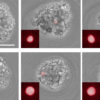How do scientists detect new variants of the virus that causes COVID-19? The answer is a process called DNA sequencing.
Researchers sequence DNA to determine the order of the four chemical building blocks, or nucleotides, that make it up: adenine, thymine, cytosine and guanine. The millions to billions of these building blocks paired up together collectively make up a genome that contains all the genetic information an organism needs to survive.
When an organism replicates, it makes a copy of its entire genome to pass on to its offspring. Sometimes errors in the copying process can lead to mutations in which one or more building blocks are swapped, deleted or inserted. This may alter genes, the instruction sheets for the proteins that allow an organism to function, and can ultimately affect the physical characteristics of that organism. In humans, for example, eye and hair color are the result of genetic variations that can arise from mutations. In the case of the virus that causes COVID-19, SARS-CoV-2, mutations can change its ability to spread, cause infection or even evade the immune system.
We are both biochemists and microbiologists who teach about and study the genomes of bacteria. We both use DNA sequencing in our research to understand how mutations affect antibiotic resistance. The tools we use to sequence DNA in our work are the same ones scientists are using right now to study the SARS-CoV-2 virus.
The first human genome took two decades to sequence. With advances in technology, scientists are now able to sequence DNA in a matter of hours.
How are genomes sequenced?
One of the earliest methods scientists used in the 1970s and 1980s was Sanger sequencing, which involves cutting up DNA into short fragments and adding radioactive or fluorescent tags to identify each nucleotide. The fragments are then put through an electric sieve that sorts them by size. Compared with newer methods, Sanger sequencing is slow and can process only relatively short stretches of DNA. Despite these limitations, it provides highly accurate data, and some researchers are still actively using this method to sequence SARS-CoV-2 samples.
Since the late 1990s, next-generation sequencing has revolutionized how researchers collect data on and understand genomes. Known as NGS, these technologies are able to process much higher volumes of DNA at the same time, significantly reducing the amount of time it takes to sequence a genome.
There are two main types of NGS platforms: second-generation and third-generation sequencers.
Second-generation sequencing marks each nucleotide with a specific color.
Second-generation technologies are able to read DNA directly. After DNA is cut up into fragments, short stretches of genetic material called adapters are added to give each nucleotide a different color. For example,…



